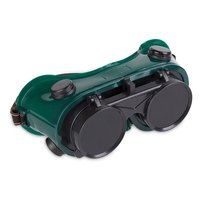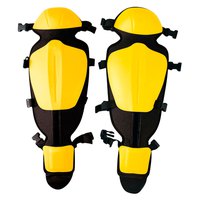Hardware Safety
()Sort by
-

Edm Signage Adhesive Tape 50 x30 m
2.99 €
-

Normaluz Pulsador Alarma 0.7 mm Sign 21x30 cm
2.49 €
-

Dunlop Rubber Boot
15.99 €
-

Flash Led LED SOS V16 Emergency Vehicle Light
47.42 €
-

Normaluz Prohibido Cámaras Fotográficas Sign 30x40 cm
2.99 €
-

Cofra Gronked Retention Cord
82.99 €
-

Normaluz Cafetería Sign
2.99 €
-

Edm 90189 Microfiber Wipes 2 Units
1.99 €
-

Edm Es Obligatorio El Uso De Mascarilla Sign 210x300 mm
1.99 €
-

Bosch ProClick Tool Belt
6.49 €
-

Bosch Kit ProClick 108 GWT2/GWT4 + 2xSop Tool Belt
105.99 €
-

Wolfcraft FFP2 V Dust Mask 3 Units
8.49 €
-

Kreator Lens PC Safety Glasses
3.99 €
-

Kreator Welder Glasses
4.49 €
-

Kreator Pvc Valve Safety Glasses
4.99 €
-

Normaluz 9021 Construction Works Signal Post 50x90 cm
8.99 €
-

Normaluz 9022 Construction Works Signal Post 50x90 cm
8.99 €
-

Normaluz 9023 Construction Works Catalán Signal Post 50x110 cm
10.49 €
-

Normaluz B11150 Stairs Signal Post 32x16 cm
2.49 €
-

Normaluz B11151 Stairs Signal Post 32x16 cm
2.49 €
-

Normaluz Salida Signal Post 22.4x30 cm
1.99 €
-

Wolfcraft FFP2 NR Dust Mask 3 Units
5.99 €
-

Masterclass Cut Resistant Gloves
7.99 €
-

Garland 7199000016 Protection Shin Guards
17.99 €
-

Normaluz Atención Baja Temperatura Sign 30x40 cm
2.99 €
-

Normaluz Empujar Barra Para Abrir Puerta 0.7 mm Sign 22.4x30 cm
1.99 €
-

Normaluz Extintor 1 mm Sign 21x30 cm
5 €
-

Normaluz Parking Sign 30x40 cm
2.99 €
-

Normaluz Paso Obligatorio El Uso De Protección Acústica Sign 30x40 cm
2.49 €
-

Normaluz Paso Obligatorio Para Personas Sign 30x40 cm
2.99 €
-

Normaluz Prohibido Fumar Sign 30x40 cm
2.99 €
-

Normaluz Puerta Cortafuegos Sign 21x30 cm
5.99 €
-

Normaluz Pulsador Alarma 1 mm Sign 21x30 cm
5 €
-

Normaluz Punto De Renuión 0.7 mm Sign 22.4x30 cm
1.99 €
-

Normaluz Right Arrow Sign 16x32 cm
5 €
-

Normaluz Salida De Emergencia Sign 15x30 cm
5.99 €
-

Normaluz Se Alquila Sign 45x70 cm
2.99 €
-

Normaluz Se Traspasa Sign 45x70 cm
1.99 €
-

Normaluz Cuidado Recién Pintado Sign 30x40 cm
2.99 €
-

Normaluz Cuidado Suelo Resbaladizo Sign 30x40 cm
2.99 €
-

Normaluz Es Obligatorio El Uso De Mascarilla Sign 30x40 cm
2.99 €
-

Normaluz Espacio Sin Humo Sign 30x40 cm
2.99 €
-

Normaluz Left Arrow Sign 16x32 cm
5 €
-

Normaluz No Utilizar En Caso De Incendio 0.7 mm Sign 21x30 cm
2.49 €
-

Normaluz Prohibido Comer Y Beber Sign 30x40 cm
2.99 €
-

Normaluz Punto De Renuión 1 mm Sign 22.4x30 cm
5 €
-

Normaluz Se Vende Sign 45x70 cm
2.99 €
-

Normaluz Sense Sortida Sign 15x30 cm
2.49 €
-

Normaluz Sólo Mercancías Sign 30x40 cm
2.99 €
-

Normaluz Zona De Obras Sign 30x40 cm
2.99 €
-

Normaluz Aseos Hombre Sign
1.99 €
-

Normaluz Aseos Mujer Sign
1.99 €
-

Normaluz Guardarropa Sign
1.99 €
-

Normaluz Lift Sign
1.99 €
-

Normaluz Salida Sign
1.99 €
-

Normaluz Tirar Sign
1.99 €
-

Tesa 60760 Beacon Tape 50 x33 m
9.99 €
-

Tesa 60760 Beacon Tape 50 x33 m
9.99 €
-

Tesa 60951 Anti-Slip Signaling Tape 50 x5 m
54.99 €
-

Benson Visits Counter 4 Digits
4.99 €
-

Lovyc Reusable Anti-Fog Cloth
3.49 €
-

Cofra Wrapper Bag 33x38 cm
1.99 €
-

Cofra Bryne Thermal T-Shirt
21.99 €
-

Ferrestock FSKCOS001 5 m Return Fastening Belt
4.99 €
-

Esselte 50 Wet 50 Dry Screen Cleaning Wipes
6.99 €
-

Rubi 66957 Protective Knee Pads
34.99 €
-

Normaluz Es Ven Sign 45x70 cm
1.99 €
-

Normaluz Prohibido Acceder Con Patinete 21x30 cm Informative Poster
5.99 €
-

Normaluz Zona Videovigilada 15x20 cm Informative Poster
1.49 €
-

Oem Polypropylene Cone 30 cm
5.99 €
-

Fun And Go Signage Mesh 1 x 50 m
31.99 €
-

Fun And Go 0.9x50 m Mesh Signage
96.49 €
-

Steelpro A1P3 Threaded Filter 2 Units
17.49 €
-

Steelpro FP A1 Threaded Filter 2 Units
9.99 €
-

Fun And Go G400 Polyethylene Film 2x10 m
24.99 €
-

Fun And Go G400 Polyethylene Film 2x25 m
55.99 €
-

Caterpillar CAT012213L comfort fit neoprene glove with synthetic leather palm
24.99 €
-

Ferrestock FSKCOS002 Return Fastening Belt
11.99 €
-

Powerplus POWDPGLOVE01 Work Glove
4.99 €
-

JBM 200 m barrier tape
10.99 €
-

JBM 200 m barrier tape
11.99 €
-

Stocker Chainsaw Anti-cut Gloves
34.99 €
-

Stocker Garden Tool Belt
11.99 €
-

Stocker Shears Anti-cut Gloves
16.99 €
-

Stocker Ultra-fine Nitrile Work Glove
4.99 €
-

Stocker Winter Anti-cut Touch Work Glove
16.99 €
-

Stocker Winter Gloves
9.99 €
-

Stocker Working Gloves
2.99 €
-

Stocker Working Gloves
9.99 €
-

Stocker Working Gloves
4.99 €
-

Stocker Working Gloves
6.49 €
-

Stocker Working Gloves
2.99 €
-

Stocker Matador Protective Glasses
13.49 €
-

Stocker Ontor Protective Glasses
17.99 €
-

Caterpillar CAT012202L work glove half finger
22.49 €
-

Caterpillar CAT012211J durable synthetic leather mechanical glove with padded palm
25.99 €
What to know about safety signals?
Safety signs are a kind of sign created to forewarn of hazards, denote mandatory activities or required usage of Personal protective equipment, restrict actions or things, determine the place of firefighting or safety gear, or marking of exit paths.In addition to being confronted in industrial facilities; safety signs are also located in public areas and districts, at electrical towers and Electrical substations and areas sealed for building or demolition. You can buy these safety signals from these brands: Edm, Makita, Fiskars, Oem, and Wolfcraft.
Safety signs are important in any work conditions. The primary significance of showing safety signs is to avert injury and assure staff and visitors are well cognizant of the probable dangers and dangers ahead in specific situations and environments.
Safety signals play a crucial role in ensuring the well being and security of individuals in various settings. Here are some key points to know about safety signals:
Definition: Safety signals are visual or auditory cues that convey important information regarding potential hazards, emergency situations, or safety protocols. They are designed to alert and inform individuals about potential risks or actions to take to ensure their safety.
Purpose: The primary purpose of safety signals is to communicate vital information quickly and effectively. They serve as a means of warning individuals about potential dangers, guiding them during emergency situations, or providing instructions to follow in order to prevent accidents or injuries.
Types: Safety signals can take various forms depending on the context and intended purpose. They can include warning signs, alarm systems, sirens, flashing lights, verbal announcements, hand signals, or even written instructions. The choice of safety signal depends on the specific environment and the nature of the information being conveyed.
Standardization: Safety signals often follow established standards and conventions to ensure universal understanding. For example, specific colors and symbols are commonly used for indicating different types of hazards or emergency situations. Standardized safety signals help promote consistency and clarity across different locations and facilitate rapid comprehension in critical situations.
Compliance and training: It is important for individuals to be familiar with safety signals and understand their meanings. Organizations and institutions often provide safety training and education to ensure that people are aware of the signals used in their specific environments. This training helps individuals respond appropriately and take necessary actions when encountering safety signals.
Legal requirements: In certain industries or public spaces, compliance with safety signal regulations and standards is mandated by law. This ensures that appropriate safety measures are in place to protect individuals and minimize the risk of accidents or injuries. Compliance with these regulations is essential for maintaining a safe and secure environment.
Maintenance and updates: Regular maintenance and inspection of safety signals are essential to ensure their functionality and visibility. Faded or damaged signs, malfunctioning alarm systems, or outdated information should be promptly addressed to maintain their effectiveness.

























